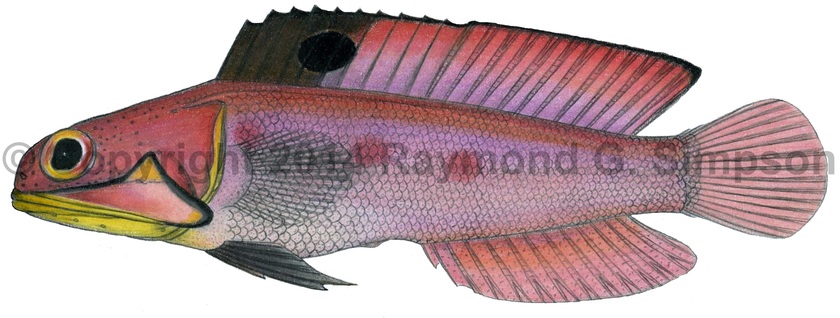
Common Name
Megamouth Jawfish
Year Described
Smith-Vaniz, 1972
Identification
Dorsal Fin: X, 13-14
Anal Fin: II, 12-13
Pelvic Fin: I, 5
Pectoral Fin: 20-22
Gill Rakers: 27-30 (total)
Vertebrae: 10 precaudal, 18 caudal; 28 total
Maxilla of males with thin, flexible posterior extension. Jaws huge; reaching well past rear margin of orbit. Premaxillary and dentary with teeth. Vomer without teeth. Lateral line extends posteriorly to between 4th and 5th segmented dorsal ray. Nape, head, pectoral base, and area above lateral line scaleless. Rest of body fully scaled. Lateral scale rows: 48-51. Dorsal fin high. Dorsal fin spines slender with sharp, flexible tips. Anterior nostril without cirrus.
Color
Body red grading to bright lavender on the sides. Three red blotches on the side: one on pectoral base, one past pectoral fin, and one above anal fin. Dorsal fin black from spines 1-6 in larger males and with an ocellated black spot in small specimens. Rear part of dorsal fin reddish with lavender basally and black distally (males) or yellowish (juveniles). Anal fin reddish with black speckling. Caudal fin pink. Pelvic fins dark red to black. Premaxilla and maxilla red with a wide black stripe on the maxillary margin. Inside of mouth, lower jaw, gular area, and opercular membranes orange-yellow.
Size
Ranges from 31-77mm SL.
Habitat
A deepwater species living between 146-265m.
Range
So far known only from the Yucatan Peninsula (Arrowsmith Bank).
References
Smith-Vaniz, W. F. 1972. Two new species of Caribbean deep-dwelling jawfishes (Opistognathus, Opistognathidae). Copeia (1): 48-53.
Smith-Vaniz, W. F. 1997. Five new species of jawfishes (Opistognathus: Opistognathidae) from the western Atlantic Ocean. Bulletin of Marine Science v. 60 (3): 1074-1128.
Other Notes
This species and Opistognathus melachasme were once considered a single species with extreme sexual dimorphism (Smith-Vaniz, 1972), but additional collections showed that there are two separate species involved (Smith-Vaniz, 1997).